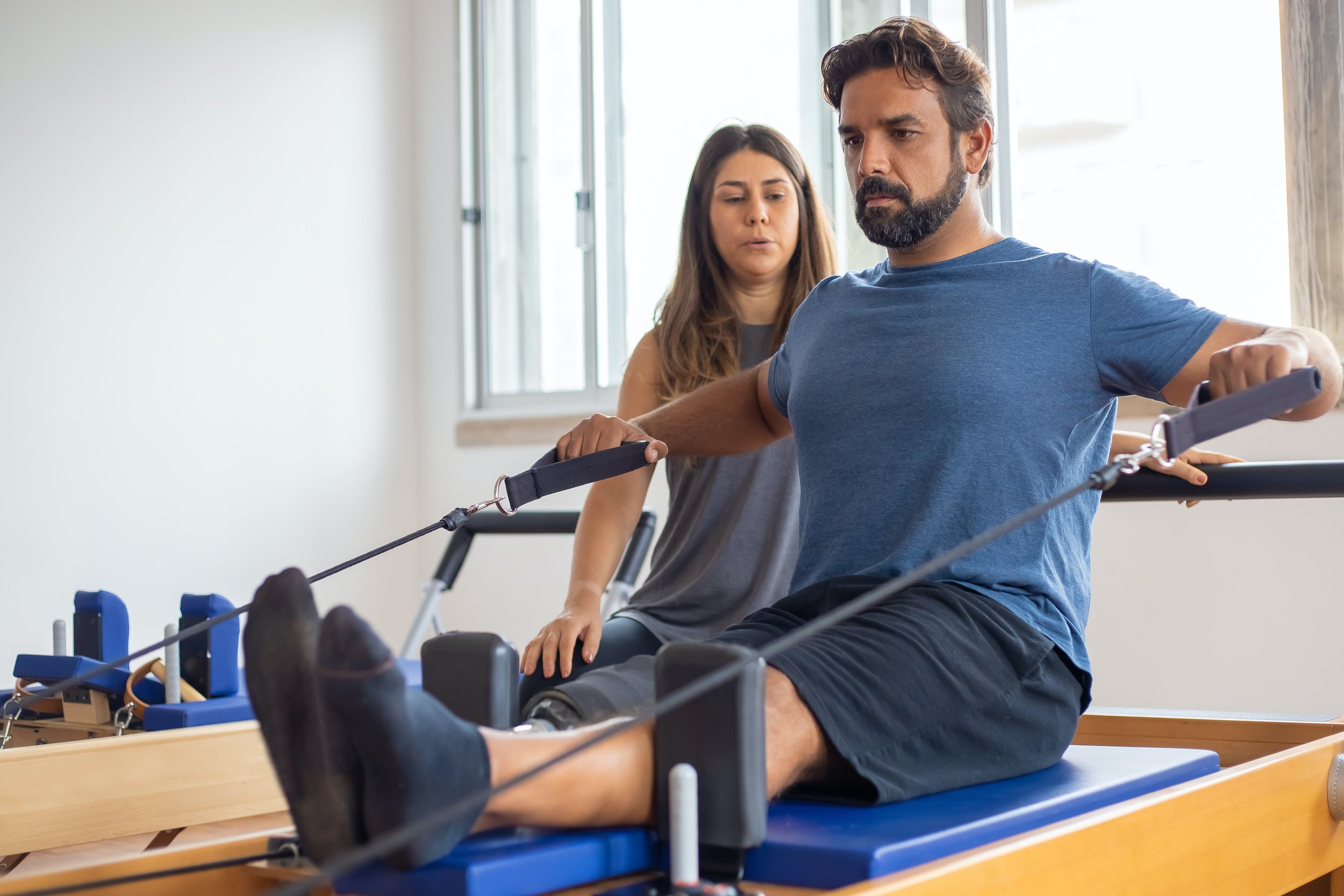Are you recovering from an injury or struggling with limited movement and function? Physical therapy may be the solution for you. And at the heart of physical therapy is the power of therapeutic exercises. In this blog, we will take a deep dive into the world of therapeutic exercises in physical therapy.
We will begin by understanding the role of therapeutic exercises and how they can help restore movement and function in the body. We will explore key aspects of physical rehabilitation, such as addressing muscle imbalances and strengthening weakened areas. Additionally, we will discuss how therapeutic exercises improve coordination and contribute to meeting individual rehabilitation goals through customized programs.
Furthermore, we will explore various therapeutic exercise techniques, including range of motion exercises, proprioceptive neuromuscular facilitation (PNF), isometric and isotonic resistance exercises, and manual resistive exercises for muscle strengthening. Lastly, we will highlight why aerobic/endurance exercises are integral to physical therapy. Get ready to discover the transformative power of therapeutic exercises in physical therapy!

Understanding the Role of Therapeutic Exercises in Physical Therapy
Therapeutic exercises play a vital role in physical therapy by restoring movement and function for a longer period of time. These exercises are designed to improve strength, flexibility, balance, and coordination. Whether targeting specific areas of the body or focusing on overall body conditioning, therapeutic exercises are personalized to an individual’s condition and goals. Implementing a regular exercise program can accelerate recovery, mitigate the risk of future injuries, and enhance overall well-being. By harnessing the power of therapeutic exercises, physical therapists offer patients a holistic approach to rehabilitation and functional restoration.
The Significance of Restoring Movement and Function
Therapeutic exercises play a crucial role in physical therapy as they aim to restore movement and function in individuals with injuries or conditions. These exercises focus on improving strength, flexibility, endurance, balance, and coordination. By customizing exercise programs based on the individual’s specific needs and goals, physical therapists help reduce pain, increase range of motion, and improve overall physical fitness. Examples of therapeutic exercises include stretching, strengthening exercises using resistance bands or weights, balance training, and cardiovascular exercises. Expert guidance from a physical therapist ensures proper form and progressions in the exercise program.

Key Aspects of Physical Rehabilitation
Therapeutic exercises play a crucial role in physical rehabilitation by improving strength, flexibility, and range of motion. These exercises are tailored to meet individual needs and can target specific areas of the body. Physical therapists utilize therapeutic exercises to help patients regain mobility and functionality after injury or surgery. Additionally, these exercises can aid in managing chronic pain and preventing future injuries. Regular participation in therapeutic exercises not only enhances overall physical fitness but also improves the quality of life.
Addressing Muscle Imbalances
Muscle imbalances can lead to improper movement patterns and potential injury. Physical therapy exercises, including resistance training, stretching, and functional movements, can address these imbalances. Therapists prescribe specific exercises targeting affected muscle groups to restore balance and improve overall function. By strengthening weak muscles and stretching tight ones, therapeutic exercises alleviate pain, improve mobility, and promote proper biomechanics, preventing future injuries. Regularly performing these exercises enhances strength, flexibility, and coordination, leading to improved movement and function.
Strengthening Weakened Areas
Therapeutic exercises play a vital role in physical rehabilitation by strengthening weakened areas of the body. Each exercise is customized to meet the specific needs and abilities of the patient, focusing on targeted muscle groups and movement patterns. Physical therapists gradually increase the intensity and duration of these exercises to help patients regain strength, improve flexibility, and restore normal range of motion. Additionally, therapeutic exercises enhance balance, coordination, and proprioception, which are essential for daily activities and injury prevention. Various equipment and techniques, such as resistance bands and balance boards, are utilized to provide targeted strengthening and support.
Improve Coordination
Therapeutic exercises enhance coordination by targeting specific muscle groups and movements. These exercises strengthen weak muscles, improve balance and stability, and retrain the brain and body to work together more efficiently. Regular practice leads to improved coordination, motor control, and functional ability.

Customized Therapeutic Exercises: Meeting Individual Rehabilitation Goals
Customized therapeutic exercises are a vital component of physical therapy, as they are tailored to meet the specific needs and goals of each individual. These exercises target areas that require improvement, such as strength, flexibility, balance, and coordination. By incorporating personalized exercise programs, physical therapists can gradually progress the intensity and duration of the exercises based on the patient’s condition. This approach not only aids in restoring mobility and function after an injury or surgery but also helps manage chronic pain and prevent future injuries. Regular practice of these exercises leads to long-term improvements in overall physical well-being.

Exploring the Benefits of Therapeutic Exercises in Physical Therapy
Therapeutic exercises in physical therapy offer numerous benefits. They improve flexibility, restore range of motion, enhance balance and coordination, and strengthen weak muscles. These exercises are customized to meet individual rehabilitation goals, making them effective for various conditions and injuries. Regular practice leads to long-term improvements in overall physical well-being and helps prevent future injuries. the Range of Therapeutic Exercise Techniques
Types of therapeutic exercises, such as stretching, strengthening, balance, and coordination exercises, form the foundation of physical therapy. These exercises offer numerous benefits, including improved flexibility, reduced pain, and restored mobility. Physical therapists customize exercise programs based on the individual needs and goals of each patient, taking into account their medical history and specific condition or injury. By incorporating specific therapeutic exercises, such as range of motion exercises and proprioceptive neuromuscular facilitation (PNF), therapists aim to optimize outcomes and enhance the overall quality of life for their patients. Correct technique and progressive exercise programs are vital to achieving optimal results.
Range of Motion Exercises
Range of motion exercises play a crucial role in physical therapy by improving flexibility and joint mobility. These exercises involve moving a joint through its full range of motion, either actively or with the assistance of a therapist or equipment. By regularly performing range of motion exercises, patients can prevent stiffness and maintain or restore normal joint function. These exercises are commonly used in physical therapy to treat various conditions such as arthritis, post-surgical recovery, and musculoskeletal injuries. Examples of range of motion exercises include shoulder circles, ankle pumps, and wrist flexion and extension.
Proprioceptive Neuromuscular Facilitation (PNF)
Proprioceptive Neuromuscular Facilitation (PNF) is a technique utilized by physical therapists to enhance muscle strength, flexibility, and coordination. PNF involves a combination of stretching and contracting muscles, stimulating a neurological response that increases muscle activation. This technique is effective in treating a wide range of conditions, including stroke, spinal cord injuries, and musculoskeletal disorders. PNF exercises typically incorporate resistance bands or manual resistance provided by the therapist. The ultimate objective of PNF is to enhance functional movement patterns and restore normal movement and function in patients.
Isometric and Isotonic Resistance Exercises
Isometric and isotonic resistance exercises are two main types of therapeutic exercises commonly used in physical therapy. Isometric exercises involve contracting muscles without movement, such as holding a static position, and are often used for muscle strengthening and building endurance. On the other hand, isotonic exercises involve movement of joints and muscles, such as lifting weights or performing squats, and can improve joint flexibility, muscle strength, and overall functional movement. Both types of exercises can be tailored to the individual’s specific needs and goals in physical therapy.
Manual Resistive Exercises
Manual resistive exercises play a crucial role in muscle strengthening during physical therapy. These exercises involve the use of external resistance, such as weights or resistance bands, to target specific muscle groups and improve strength. By challenging the muscles to work harder through resistance applied by the therapist, patients can regain strength and function after an injury or surgery. Manual resistive exercises are highly customizable to suit each patient’s individual needs and abilities, ensuring targeted muscle strengthening. Under the guidance of a trained physical therapist, these exercises can be performed with proper form and progression.

Therapeutic exercises play a crucial role in physical therapy by restoring movement and function to individuals who have experienced injury, surgery, or other physical limitations. These exercises address muscle imbalances, strengthen weakened areas, improve coordination, and help meet individual rehabilitation goals. Additionally, aerobic/endurance exercises are integral to physical therapy as they improve cardiovascular health and overall fitness. If you’re looking to restore your movement and function through therapeutic exercises, consult with our expert physical therapists, who will assess your condition and develop a customized exercise program tailored to your needs. Take the first step towards restoring your mobility and book a consultation with us today.





